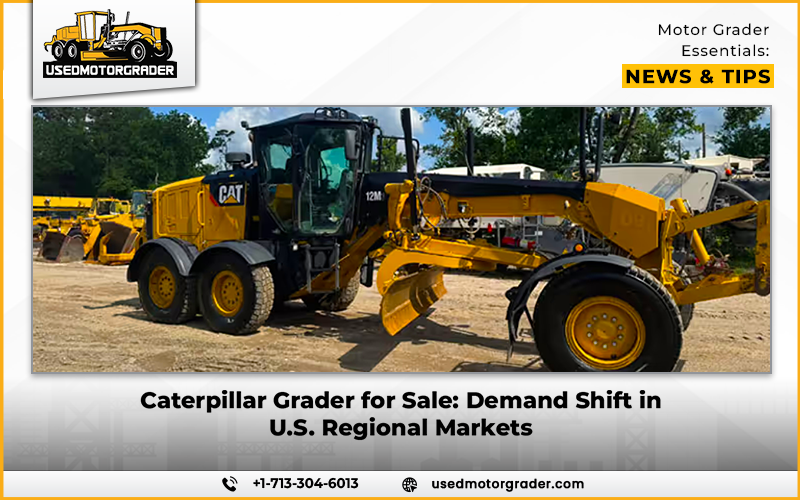If you’ve been browsing the heavy equipment resale market lately, you might have noticed something odd: used Caterpillar grader for sale models from the Southern United States are attracting serious attention well beyond their local region. In fact, buyers from northern states, and even international importers, are showing a growing interest in graders that have spent their working lives below the Mason-Dixon line. It’s not just a coincidence. There’s a quiet shift happening in the resale market, and Southern machines are quietly gaining an edge. Here’s why.
The Climate Story Behind Low-Corrosion Machines
When it comes to construction equipment, location isn’t just a detail, it’s a major factor in a machine’s long-term condition. Graders that have been operating in the South typically enjoy far milder winters, which means they avoid one of the harshest enemies of machinery: road salt. In colder northern states, winter maintenance often includes heavy use of salt and other de-icing chemicals that can eat away at metal components, frames, and undercarriages over time. By contrast, a grader from a region like Texas, Alabama, or Georgia might go their entire life without experiencing a single salt-covered road. That gives these southern machines a serious head start when it comes to longevity, and that kind of condition difference doesn’t go unnoticed by savvy buyers.
Why Northern Contractors Are Looking South
It might seem strange that a contractor in Michigan or upstate New York would be scouring Louisiana listings, but it actually makes perfect sense. When construction season opens, there’s little room for downtime, and contractors need machines that can perform reliably without excessive maintenance or costly repairs. Buying a well-maintained, rust-free unit from the South gives them that edge. On top of that, many northern states have older public fleets or more intense wear-and-tear cycles due to freezing temperatures. As demand for updated machines grows, buyers are turning their gaze southward to find the best options before the season hits full swing.
The Export Market’s Growing Appetite
While buyers from the north are certainly interested, they’re not the only ones shopping for southern iron. International buyers are increasingly setting their sights on U.S.-based Caterpillar grader for sale models, especially those located in or near Gulf Coast states. The reasoning is simple: proximity to ports makes logistics easier. Graders from the South tend to be in better condition than those from snowy northern regions. Countries with less stringent emissions regulations or more flexible import standards often prefer machines that are cleaner and visually well-kept, even if they’re a few years older. Southern graders check those boxes. As export demand heats up, it naturally squeezes domestic availability, pushing even more northern buyers into competition for the same machines.
Supply is Shrinking, and That’s Shaping Prices
The balance between supply and demand is always in motion, but the southern grader market is starting to feel a squeeze. As word spreads about the benefits of these low-corrosion units, listings don’t stay live for long. Dealers in the South are becoming increasingly aware of the resale potential, and they’re beginning to adjust prices accordingly. In some cases, companies are now marketing graders that would have once been sold locally with a broader reach. Knowing they’ll fetch a higher price from northern or international buyers. That shift is starting to tip the scales. It’s not unusual now to see southern units commanding a noticeable premium. Especially when they come with a clean maintenance record and under 8,000 hours of use.
Buyers Are Getting Smarter About What’s Under the Hood
Just because a machine looks good doesn’t mean it hasn’t worked hard. Smart buyers know this. While southern graders might be spared the rust, they aren’t immune to wear in other areas. For example, long-distance grading on hot, dry highways can lead to excessive idling hours or stress on hydraulics. Buyers are increasingly requesting detailed telematics data or engine control module reports to verify how a grader has really been used. A shiny yellow frame is a great start, but it doesn’t tell the whole story. As resale values climb, due diligence is becoming more important than ever.
Condition Isn’t Everything, Fit for Climate Still Matters
One overlooked detail in all this southern-to-northern movement is operational fit. A Caterpillar grader for sale that’s been running in 60–80°F weather its whole life might not be outfitted for the rigors of a northern winter. Features like engine block heaters, enclosed cabs with insulation, or snow wing attachments might be absent. That means northern buyers need to factor in the cost and time of retrofitting. It’s a solvable issue, but not one to ignore. If you’re buying from another region, make sure the grader isn’t just clean. It should also be capable of adapting to your climate and jobsite needs.
Changing Dealer Strategies Reflect Market Shifts
Southern dealers have caught on to the trend, and it’s beginning to influence how they present and price their machines. Instead of relying solely on local customers, many dealers are building out stronger online listings. Providing more high-resolution photos, inspection reports, and even walkaround videos to reach buyers further north. Some are even partnering with logistics providers to simplify the purchase and delivery process across state lines. This shift isn’t just helping individual sellers, it’s reshaping how the resale ecosystem functions. With more transparency and regional targeting than ever before.
What This Means for Buyers Watching the Market
For contractors, fleet managers, and equipment buyers, the takeaway is clear: don’t underestimate regional trends. A Caterpillar grader for sale in Alabama might offer more long-term value than a similar unit located just a few hundred miles north. But value isn’t just about price, it’s about performance, reliability, and cost of ownership. As southern machines gain popularity, the competition for them will likely intensify. So spotting good deals early and asking the right questions becomes critical. Whether you’re gearing up for next season or thinking long-term fleet strategy. Paying attention to where a machine comes from might just give you the edge.


